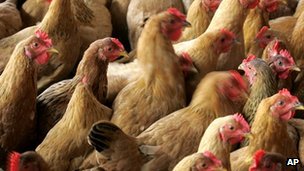Bird flu outbreak in China spreading...

China: Four more infected with H7N9 bird flu
3 April 2013 - A further four cases of a bird flu virus not previously seen in humans have been reported by authorities in China.
See also:
Scientists Race to Assess New Bird Flu's Pandemic Risk
April 03, 2013 Genetic sequence data on a deadly strain of bird flu previously unknown in people show the virus has already acquired some mutations that might make it more likely to cause a human pandemic, scientists say.
China: Four more infected with H7N9 bird flu
3 April 2013 - A further four cases of a bird flu virus not previously seen in humans have been reported by authorities in China.
Three women aged 32, 45 and 48, and an 83-year-old man were diagnosed between 19 and 21 March and are critically ill. There have now been seven confirmed cases of the H7N9 virus, the World Health Organization said. Two people have died. But the WHO says there is no evidence of human-to-human transmission. However more than 160 people who have had contact with the individuals are being closely monitored.
So far, none has developed symptoms. The latest cases were seen in the Jiangsu province while the earlier cases were in the Shanghai and Anhui provinces. Two contacts of one of the Shanghai cases who developed symptoms are being retrospectively investigated. One died and the other recovered, but as yet there has been no laboratory confirmation of whether they were infected with H7N9.

H7N9 is a form of bird flu
Hygiene measures
The Chinese government has increased disease surveillance, infection prevention and control and communication between human and animal health and industry sectors. It has advised the population to maintain good personal hygiene, including frequent hand-washing and avoiding direct contact with sick or dead animals. The WHO is not recommending any travel or trade restrictions.
Dr John McCauley, Director of WHO Collaborating Centre on Influenza at the MRC National Institute for Medical Research, said: "The virus belongs to the A(H7N9) sub-type, a sub-type that has not previously infected humans, and has emerged from the reservoir of avian influenza viruses. "It is not known how the virus was transmitted. "By identifying the source of infection, measures can be taken to reduce human exposure. "The Chinese Center for Disease Control and Prevention is investigating whether there has been any human-to-human transmission." Tests suggest the virus could be treated with the anti-influenza drugs Tamiflu and Relenza.
BBC News - China: Four more infected with H7N9 bird flu
See also:
Scientists Race to Assess New Bird Flu's Pandemic Risk
April 03, 2013 Genetic sequence data on a deadly strain of bird flu previously unknown in people show the virus has already acquired some mutations that might make it more likely to cause a human pandemic, scientists say.
But there is no evidence so far that the H7N9 flu - now known to have infected nine people in China, killing three - is spreading from person to person, and there is still a chance it might peter out and never fully mutate into a human form of flu. Just days after authorities in China announced they had identified cases of H7N9, flu experts in laboratories across the world are picking through the DNA sequence data of samples isolated from the patients to assess its pandemic potential.
One of the world's top flu experts, Ab Osterhaus, who is based at the Erasmus Medical Centre in The Netherlands, said the sequences show some genetic mutations that should put authorities on alert and entail increased surveillance in animals and humans. "The virus has to a certain extent already adapted to mammalian species and to humans, so from that point of view it's worrisome," he told Reuters in a telephone interview. "Really we should keep a very close eye on this."

Technicians carry out a test for the H7N9 bird flu virus using test reagents at the Beijing Center for Diseases Control and Prevention in Beijing
New cases
China's National Health and Family Planning Commission confirmed on Sunday that three people had been infected with the new H7N9 flu, with two deaths of men in Shanghai aged 87 and 27 who fell sick in late February. Chinese authorities have in the past two days confirmed another six cases, including another fatal one. The World Health Organization [WHO] says the cases of H7N9 are "of concern" because they are the first in humans. "That makes it a unique event, which the World Health Organization is taking seriously,'' the Geneva-based United Nations health agency said on Wednesday. Other strains of bird flu, such as H5N1, have been circulating for many years and can be transmitted from bird to bird, and bird to human, but not from human to human.
So far, this lack of human-to-human transmission also appears to be a feature of the H7N9 strain. Flu viruses are classified based on two types of protein found on their surface, haemagglutinin and neuraminidase, which are abbreviated to H and N. Although it is very early days, scientists say initial analysis also suggests H7N9 does not appear to make birds particularly ill - in other words it is what is known as a low pathogenic avian influenza, of LPAI. Unfortunately, this doesn't necessarily mean it will be mild in humans, says Wendy Barclay, a flu virology expert at Britain's Imperial College London.
Finding the source




